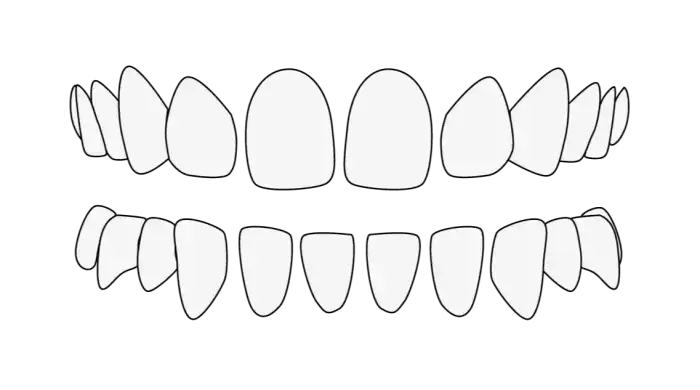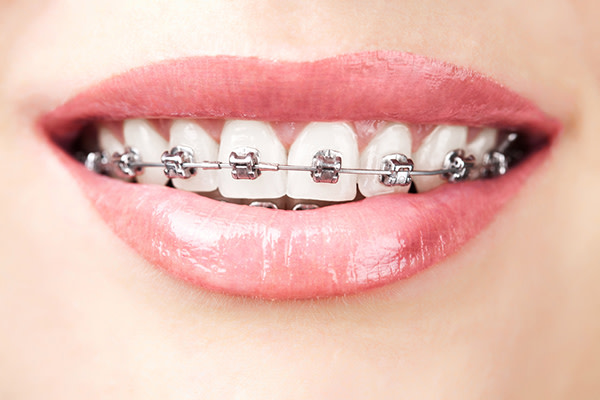Teeth misalignment: Diastema
A smile with a little something
Am I eligible?

A small gap between the incisors makes a smile special and somehow likeable. Some people find them beautiful, others are ashamed of them. If a whole tooth is missing or there are many small gaps between the teeth, many adults find it very uncomfortable. This is because teeth in some ways reflect our grooming habits and our wealth. Straight teeth are perceived by the others as young and healthy. But very few people are blessed by nature with a Hollywood smile. If the misalignments cause problems, they should be corrected to prevent later complications. If a correction is not medically necessary, you don't have to live with the diastema if you feel uncomfortable. Fortunately, aesthetic dentistry offers a variety of treatment options.
Cause for diastema

The causes of diastema (gap) are varied. On one hand, they can be hereditary. If there are many small gaps between in the teeth, this is called diastemata. This is caused by a disproportion between the size of the teeth and the size of the jaw. A gap between the front incisors may also be caused by a frenulum in the mouth that is too deep. On the other hand, a missing tooth that had to be extracted due to an accident or caries may cause a gap.
Diastema between the incisors

The so-called diastema (ancient Greek for "space between") is polarising. Particularly because it has become a trend in Hollywood and in the modelling industry. The gap between the incisors stands out from the crowd and has character. Madonna wears it with pride, it has become a kind of trademark. But not everyone feels comfortable with a gap between their teeth. As we all know, beauty is always in the eye of the beholder. While some people are self-confident about their gap, others are affected negatively by it. Especially when the gap becomes larger, many adults find a diastema unattractive and want to hide it. Fortunately, modern dentistry has tremendous possibilities when it comes to closing gaps between teeth. But whether it is a trend or a flaw, each person can decide for themselves whether they want to keep the gap or have it corrected.
To close or not to close?
In most cases - especially in the anterior area - the closing of a diastema serves exclusively to restore the aesthetics. It is not medically necessary to have them closed. Smaller gaps are absolutely harmless. However, if the gap affects speech or if the teeth shift, the gap should be closed. If a whole tooth is missing in the posterior region, it should be replaced. Otherwise, other teeth will move towards each other, causing further imbalances in the jaw.
An important factor is the cost of dental treatment. If the gap between the teeth is to be closed for purely aesthetic reasons, health insurance will not cover the costs.
Closing the gap with braces or aligners
One way to make a gap between the teeth disappear is to correct it with braces. In addition to fixed braces with brackets and wires, there is also the option of moving the teeth into the correct position with clear aligners.
Clear aligners
The so-called aligners are particularly suitable for adults. The treatment is discreet and hardly restricts the wearer in everyday life. The aligners are therefore an aesthetically pleasing alternative to visible braces. Another advantage is the cost and duration of aligner treatment. Both are significantly lower compared to fixed braces. For example, while a aligner treatment at DrSmile cost between £1,390 € - £2,090, you can easily pay up £5,000 - 6,000 for fixed braces or other providers of aligners. Depending on the complexity of the initial condition, treatment can be successfully completed after just a few months. With the small clear aligners, a diastema or several gaps can be quickly and inexpensively corrected.
Braces

In addition to aligners, there is also the possibility of fixing diastema with fixed or loose braces. This is the standard treatment for children and adolescents, as their jaws are still growing, which can be easily corrected with braces. However, many adults shy away from braces because of the visibility, regular visits to the dentist and the restrictions it have on their professional and private lives. The only option for adults is fixed braces from the inside, where the brackets are glued to the inside of the teeth. However, fixed braces are often not necessary and clear aligners are sufficient to move the teeth into the desired position. If you compare the prices of £1,390 € - £2,090 (aligner) and £5,000 - £6,000 (fixed braces), the savings are substantial.
Closing diastema without braces
Aligners and braces can correct many misalignments. But they also have their limits. In cases such as tooth loss due to caries or an accident, unfortunately, braces cannot provide a remedy. Modern dentistry offers other alternatives to close the gap between the teeth. If you don't fancy an aligner or fixed braces and want a quick fix, you'll have to dig deeper into your pocket.
Dental composite: gentle on teeth
For small gaps or blemishes, a composite filling is a good and cost-effective correction option. Composites are the smallest and most modern filling materials. They consist of a plastic matrix that is mixed with ceramic fillers. The composite is applied directly to the tooth during treatment and requires skilled eyes for aesthetics as well as a high degree of dexterity. It is crucial to match the correct tooth shape and colour to achieve a satisfactory result. This procedure does not remove any tooth layers, which is why it is gentle on the teeth.
Veneers: durable but expensive
Veneers are wafer-thin, transparent layers made of ceramic. They are individually made and hard to differentiate from real teeth with the naked eye. With the so-called prep veneers, a thin layer of the patient's own tooth is grounded off, which is why they can usually last between 15-20 years. Veneers are especially suitable if, in addition to a gap between the teeth, the shape of the teeth also needs to be adjusted. However, due to individual fitting and the material, the costs of veneers are very high. This particular treatment is an option if there is no other alternatives or if a quick result is desired without a long waiting period.
Dental implant or bridge: for tooth loss
If a whole tooth is missing, e.g. due to an accident or caries, it has to be replaced by an implant or a bridge. While a bridge is attached to the neighbouring teeth, the implant is anchored in the bone and thus provides optimal support. However, the type of replacement depends on a variety of factors and should be discussed with your dentist.
Close the gap yourself
Closing a gap on your own is not a good idea and can have dangerous consequences. DIY braces made of rubber bands, where individual rubber bands are stretched around the teeth in order to move them into the right position, can lead to an injury and, in the worst case, to the loss of the teeth. Temporarily covering a gap between the incisors with cheap plastic dentures or temporary repair kits are not an elegant solution either and will certainly attract the attention of the person in front of you.
If you would like to correct your teeth in the comfort of your own home, you can do so easily with DrSmile aligners. After a detailed consultation, during which your teeth will also be scanned, you will have the aligners delivered directly to your home. You can start right away and there are no more annoying visits to the dentist every 8 weeks.